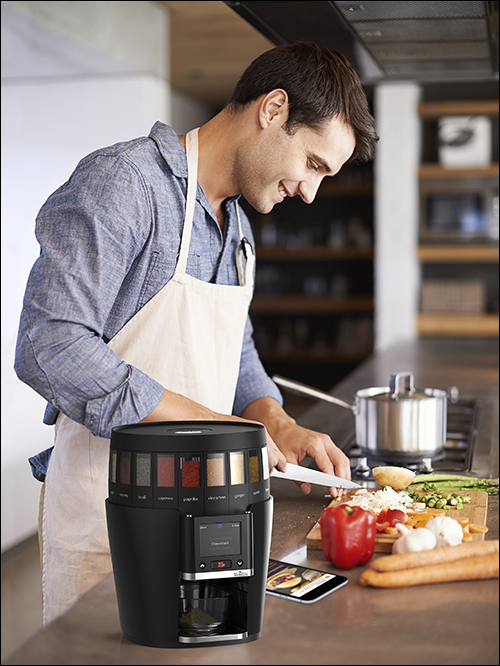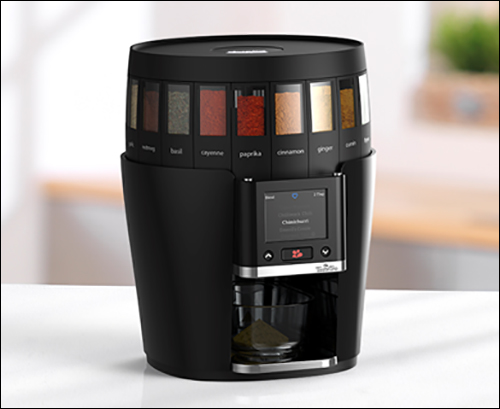Jul 18, 2018TasteTro is preparing the launch of an automated spice rack that employs Near Field Communication (NFC) RFID technology to help consumers more easily select and access spices and blends for each recipe. The system also provides a means of communication between consumers using the device and TasteTro.
The TasteTro Spice System is an intelligent spice rack designed for use in household kitchens. It provides users with selected, measured spices and blends for a specific recipe, at the press of a button, and they can scroll through and select from preprogrammed blends. The spices are then dispensed from the appliance, ranging from a quarter-teaspoon to a tablespoon for individual spices or herbs and up to one-quarter cup of a variety of blends. NFC 13.56 MHz technology, compliant with the ISO 14443 standard, enables the system to identify which spices were loaded, then access and dispense them when they are requested, and track when they need to be replenished in the rack.
The automated spice rack has been many years in the making, says James Murray, TasteTro's co-founder and CEO. In fact, he launched the Calgary-based company in 2012 to provide relief for busy people challenged with dinner recipe and menu decisions. "We worked with a team of chefs and nutritionists" to develop content for the system, he says, and engineers and an industrial designer for the system development, "trying to target those who are struggling Monday through Friday with the question 'What's for dinner?'"
The team also worked with several technology providers, including NFC and RFID company RFID Canada, to determine how the rack could identify each spice pod, and thereby know which spice to dispense, as well as how much has been dispensed and thus how soon the spice needs to be replaced.
That discussion began approximately three years ago, recalls Bob Moroz, RFID Canada's president. The resulting product consists of a circular rack surrounded by spice pods, NFC labels on each pod, an RFID reader in the center of the console, firmware on the device, software hosted on a cloud-based server and TasteTro's own app.
TasteTro opted to provide 20 of the most popular spices (such as oregano, basil, thyme and pepper), as well as blend options; a total of 50 are available with the product's initial launch. Those blends can be used in recipes for Italian dressing, for instance, or for meat rubs, marinades or smoothies in some of the 20 pods. There is also a central chamber that stores and dispenses salt in addition to the pods.
When a spice or blend has been selected, the rack's turning console rotates the pods past the NFC reader built into the center base. TasteTro has not determined which of the NFC readers it has been testing will be built into the device. The pod itself, shaped like a pie wedge, comes with an NFC label attached to its bottom, measuring 33 millimeters by 81 millimeters (1.3 inches by 3.2 inches). The off-the-shelf labels come from a variety of suppliers, Moroz says.
Each label contains printed content about the spice, along with the embedded NFC tag encoded with a unique ID number. That ID is linked to a specific spice in the software, as well as in firmware residing on the device. When the system identifies the spice it seeks for a specific request, a dispensing rod connects to the spice pod in order to access the spices contained within. The rack also has a vibration element in the center that shakes any excess spice loose from pods as product is measured out.
First, a spice rack owner inserts the loaded spice pods in any order within the appliance. The reader in the device then interrogates the tags and updates the inventory list in its firmware, as well as on a user's app. (Users can operate the spice rack without an app; however, they are limited to data that is stored on the rack firmware.)

Assuming that a user is utilizing the app while beginning to prepare a meal, he or she can select from one of 100 recipes available in the TasteTro app on his or her smartphone or tablet. The phone is connected to the spice rack via a Bluetooth connection. When the user selects a recipe on the app, the device identifies the spices or blends required and, when prompted, dispenses them. The individual can opt to increase or decrease the quantity based on the number of people being cooked for.
The firmware in the rack updates the status of each pod's available quantity every time a spice or blend is dispensed. When the amount of spice reaches a minimal level, the app or the TasteTro device itself can alert the user to reorder that spice, which can be purchased directly from TasteTro or a participating retailer. In the meantime, users can create a history of which spices, blends and recipes they like, and simply add specific spice blends to their favorites in the TasteTro app, or store them directly on the appliance by pressing the related button. Using the app, cooks can not only store favorites, but also access new recipes for inspiration.
Many of the functions available with the app can be accomplished on the device itself, Murray says, without a user having to download the app. The touchscreen on the front of the device allows users to scroll through spice and blend options, select specific blends and save favorites. They can also view when a specific spice pod needs to be replenished, based on the number of times it has been dispensed.
During the past four years, Murray says, "We've gone through five prototypes," making the system more compact and efficient. The product is expected to launch during the first quarter of 2019, while the company completes app development and further prototype testing.
"One of the key challenges was the labelling," Moroz says—that is, ensuring that all NFC labels could be read 100 percent of the time. The firm built the device with necessary shielding to ensure that the tags would be read only when located directly in front of the dispensing rod. Because the system uses NFC tags (as opposed to other RFID frequencies), an individual with an NFC-enabled smartphone could potentially read the tags on the spice pods using that phone, Moroz says, to learn more about each spice and how it could be added to recipes.



